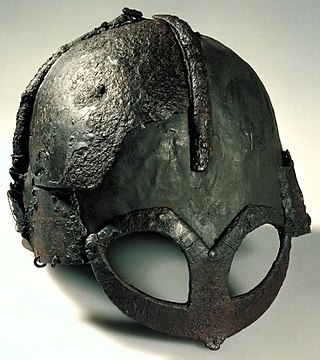Top Qs
Timeline
Chat
Perspective
Gjermundbu helmet
Viking Age helmet From Wikipedia, the free encyclopedia
Remove ads
The Gjermundbu helmet is a Viking Age helmet.[1][2]
You can help expand this article with text translated from the corresponding article in Norwegian. (March 2021) Click [show] for important translation instructions.
|
The helmet was discovered during field clearing in 1943 at the Gjermundbu farm near Haugsbygd in the municipality of Ringerike in Buskerud, Norway. Officials at the University of Oslo were later notified. Conservator Sverre Marstrander and museum assistant Charlotte Blindheim led an investigation which confirmed the existence of a burial chamber of historic value dating from the Viking Age. The Gjermundbu finds included many artifacts, including articles of weaponry.
Remove ads
The helmet
The Gjermundbu helmet was restored from nine excavated fragments. The helmet is made of iron and takes the shape of a peaked cap made from four plates. It is now on display at the Museum of Cultural History of the University of Oslo.[3][4]
Together with the Tjele helmet fragment, the Yarm helmet, the Lokrume helmet fragment, and a fragment from Kyiv, it is one of only five known Viking helmets, and one of only two that could be reconstructed.[5]
Remove ads
Discovery
Summarize
Perspective
On March 29, 1943, Gunnar Gjermundbo, planning to build a home for his parents, discovered a rich burial site in Vesleenga.[6]
Gjermundbo already knew that the site contained a large tumulus (a round Iron Age burial mound), but he had no intention of touching it. Just to the west of this burial mound was an elongated rise that he would need to level to build a house and plant a new orchard. It was when he began to dig into this embankment that artifacts began to appear. The next day, the local historian Jon Guldal informed the Oldsaksamling University in Oslo about the find by telephone. The local newspaper Ringerikes Blad published the news about the find and an interview with Gjermundbo's father Lars on March 31.[6]
The university's Antiquities Collection was notified, and conservator Sverre Marstrander and museum assistant Charlotte Blindheim were sent to investigate the matter. They carried out a post-excavation analysis of the discovery site without any further artifacts coming to light. Marstrander was able to ascertain that it was an exceptionally rich human burial from the Viking Age, and took the artifacts back to Oslo.
In May 1943, Gjermundbo discovered another grave in the same mound. Marstrander was again sent out and was able to ascertain that this was a separate grave from the same period as the first. The two burial are designated Gjermundbu I and II.
Remove ads
Site description
The embankment was originally believed to be a single, approximately 25 metres (80 ft) long, 8 metres (26 ft) wide (at its widest) and up to 1.8 metres (5.9 ft) high, burial mound. It was later determined to be two different human graves (cremations) from the Viking Age. The dimensions given for the ship-shaped mound have since been adjusted to 29 metres (95 ft) long and up to 9 metres (30 ft) wide.[6]
See also
References
Bibliography
Wikiwand - on
Seamless Wikipedia browsing. On steroids.
Remove ads

